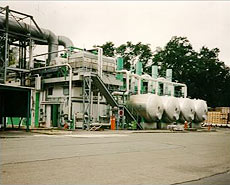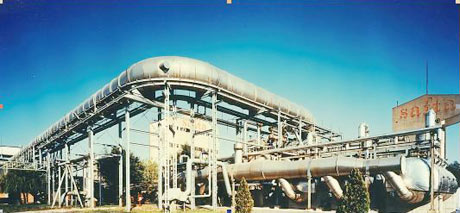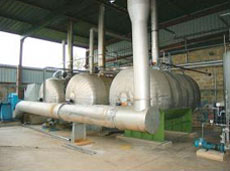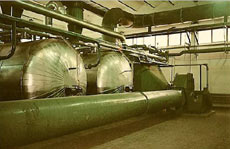ADSORPTION
The
activated carbon ( or any other solid adsorbent) adsorption process is
a simple method, but with a highly efficient
retention capacity and a possible economic payback, for
the removal and
recovery of solvent vapours contained in a gas stream.
The
standard adsorbing medium is activated carbon which is obtained from a
mineral
or vegetable raw material and then heat treated in order to obtain a
porous
material with a very large activated surface. The qualities of an
activated
vegetable carbon are usually much better than those of an activated
mineral
carbon.
|
|
The quality
of an activated carbon depends mainly on its activated surface, which
is measured in B.E.T. (acronym consisting of the initials of the names
of the three scientists who carried out this analysis method),
expressed in square meters per gram of carbon. For polluted
air treatment an activated carbon with more than 1000 m2/g
of B.E.T. should normally be used and Omniatex uses a very good carbon with at least Adsorption
is a mass transfer process because the solvent passes from the air onto
the carbon pores. The solvent molecules are attracted onto the surface
of the activated |
|
|
carbon
by forces called Van der Waals forces after the name of the scientist
who
investigated this physical phenomenon.
Adsorption
is also an exothermic process due to the fact that the solvent
vapours being in the air condense on the activated surface of the
carbon where
they are retained in the carbon pores in liquid state.
The
progressive formation of several layers of liquid solvent on the inner
part of the carbon pores gradually reduces the power of the Van der
Waals
forces until an
equilibrium is reached
and no more solvent can be caught by the pores.
Besides
its activated surface, the retention efficiency of a carbon is given by:
|
·
Chemical and physical properties of the solvent
· Chemical and physical properties of the
activated carbon · Distribution and size of pores in the activated
carbon · Air velocity through the carbon · Carbon bed depth · Relative humidity of the air stream · Air temperature · Solvent concentration in the air stream · Pressure at which the adsorption process is
carried out |
|
|
|
|
|
The solvent
retention capacity of the activated carbon at equilibrium and at a
given temperature and pressure is shown in a special diagram called
ISOTHERM, in which the adsorption capacity expressed in percentage of
solvent retained by a given type of carbon is plotted for each solvent
concentration (or partial pressure).
When reaching the isotherm curve, the same quantity of solvent entering
the carbon bed comes out of it, just because equilibrium has been
reached, i.e. the maximum retention capacity of a specific carbon
referring to a
specific solvent. |
|
Since the permissible emission limits are
usually much lower
than the emission of solvent concentrations entering the plant, the
adsorption
capacity expressed with the equilibrium isotherm must be used only
partially.
Therefore another isotherm should be used, which is called "working"
or work equilibrium isotherm, but
with a
much lower retention capacity.
The
adsorption process in the carbon bed continues through
several stages until equilibrium is reached. At the beginning the
solvent is
completely held by the carbon and the air stream leaving the carbon bed
is
completely solvent free. The solvent fills the carbon pores little by
little,
thus reducing the action of the Van der Walls forces and the solvent
mass
gradually transfers in the
carbon bed
until some solvent traces are present in the air stream coming out of
the
adsorber after passig over the activated carbon bed. This step is
called
BREAKTHROUGH of the carbon bed. Now at this stage of adsorption the
carbon bed
is filled with solvent in different ways. The part of the carbon bed
that was
in contact with the incoming solvent-laden air stream has reached the
condition
of the equilibium isotherm and the carbon is totally saturated. The
part of the
carbon bed that was in contact with the outgoing air stream is
partially
saturated since the Breakthrough started. The middle
part of the carbon bed may vary between
the two above mentioned conditions.
|
|
When the
Breakthrough condition is reached, also according to the preset
emission limit, the carbon
should be regenerated, if possible, in order to restore its initial
adsorption condition or it should be replaced with new carbon. If the
carbon can be regenerated, carbon regeneration is carried out using
regenerating media that can loosen
the bonds between
the liquid solvent and the activated carbon surface. The standard
medium is usually heat, that can be used either directly or indirectly.
|
|
|
|
|
|
Heat
supplied by steam is the cheapest regenerating medium used for
activated carbon regeneration. The heat evaporates the solvent in the
inner
side of the pores, empties them almost completely and leaves a free
activated
surface of the pore. The same effect can be achieved with less
efficiency by a
hot gas stream that lowers the partial pressure of the solvent. Usually
the
efficiency of the carbon regeneration by means of
steam, hot gas or vacuum can be assumed as
follows:
|
REGENERATING
MEDIUM, fed for 20 min |
Efficiency % |
|
Direct steam
at |
98 |
|
Hot gas at |
45 |
|
Vacuum |
25 |
|
Indirect
heating at |
15 |
|
Ó Carbon
Adsorption Handbook, Cheremisinoff / Ellerbusch - |
|
The
regeneration efficiency is mainly given by the following factors:
· chemical and physical properties of solvent
·
chemical and
physical properties of activated carbon
· regeneration
temperature
· regeneration
time
· mechanical
action of the regenerating medium inside the pores
The
adsorption process efficiency is strongly affected by the presence of
compounds in the air stream to be treated
that cannot be removed from the pores of the activated
carbon, e.g.
dust, dirt, high boilers, various chemicals, acids and polymerization
agents.
|
When these
compounds are entrained along the carbon bed, the adsorption process cannot be run with
an acceptable efficiency and the exhausted carbon must be changed; this
should be usually done a few months, max. 2-3 years, after bringing the
plant into operation. Extreme
attention should be devoted to this factor because the cost for replacing the carbon is a
very high operating cost for the final customer. If the polluted air
entering the plant is fairly free from other compounds in addition to the compound to
be removed and recovered without problems, the physical life of the
carbon will usually be 8 to 10 years. |
|
|
|
In 1989
Omniatex prepared a mathematical model showing the differentiated
adsorption
process of a given type of solvent in the bed of a given type of
activated
carbon for CNR (National Research Committee). Every
simulation should be made entering the
chemical and physical properties both of the carbon and of the solvent to be adsorbed
first and then,
possibly, be regenerated. The same model shows clearly the advance of the adsorbing phase in
the activated
carbon bed as well as of the possible regeneration and gives the possibility of comparing
different
regenerating media such as steam, vacuum and hot gas.
After
reaching
the saturation of the adsorbing mass, that can be possibly detected by
means of
an analyzer placed on the adsorber chimneys,
you go over to the regenerating phase of the activated
carbons which is
made by sending steam in countercurrent
to the stream of air to be purified.
The steam
deadsorbes the solvents from the activated carbons so that a mixture of
steam
and solvent comes out of the adsorber and flows into two exchangers
installed
in series, the first one of which will
condense the vapours and the second one will cool the
condensate.
The special
steam regenerating system employed by Omniatex SpA allows a limited
reduction
to powder of the
carbon and the use of
the same activated carbon placed in the plant when it was started for at least 8 years
without having to
sieve or compensate
the carbon lost in
order to remedy the efficiency loss, as it usually occurs in other
types of
plants.
The liquid
water-solvent mixture flows then in a decanter where two phases become
stratified, which are :
· Upper phase
(organic), almost only
solvent mixture that can be re-used as it is ;
· Lower phase
(aqueous) containing some
solvent traces.
|
|
The aqueous
phase from the separator is stored in a special tank and is
sent to the treatment plant later on. The organic
phase from the separator is stored in a special tank and is
sent to another main tank later on. In case of
solvents that are mutually miscible with water, the plant includes also
one or more distillation columns, the purpose of which is to make the
distilled water re-usable and the solvent anhydrous to such an extent
that it can be re-used for glue reticulation
or for the production of chips. |
|
a military establishment |
The various
working steps are remotely preset and controlled by means of a central
control
panel, located in a safe area, with
a
microprocessor and a PC Touchscreen allowing automatic operation both
with
timers and with signals from the emission analysing system.
The plant
was
designed taking into special consideration the ATEX Standards (CEI 31
and 64/2)
and following ones, thus reducing the danger centers of I Level, and
consequently reducing the hazard of the plant itself.




